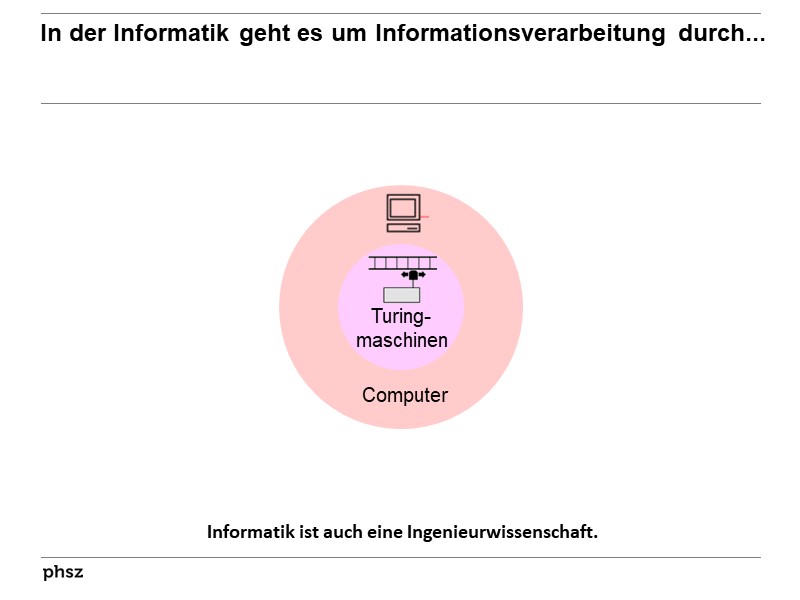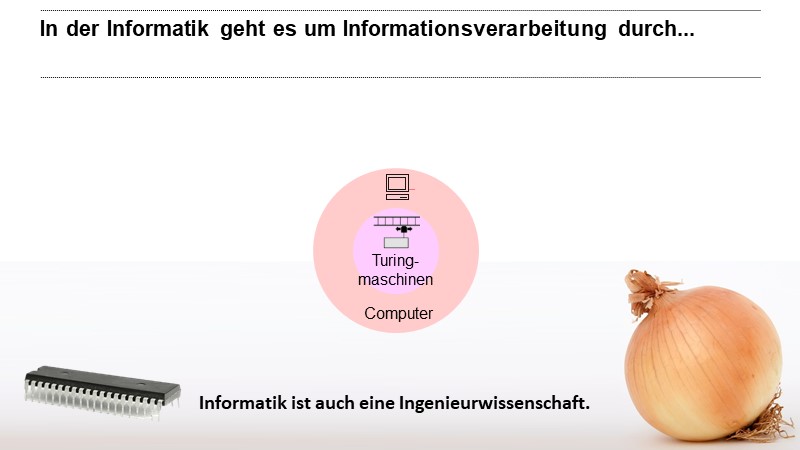Informatik = Ingenieurwissenschaft |  |
 BiblioMap
BiblioMap 
 Definitionen
Definitionen
 Computing as engineering: Many computing activities are centred around
requirement analysis, design, implementation and the evaluation and production
of useful artefacts.
Computing as engineering: Many computing activities are centred around
requirement analysis, design, implementation and the evaluation and production
of useful artefacts. Key concept: Computing as engineering
Key concept: Computing as engineeringMany computing activities are centred around requirement analysis, design, implementation, evaluation and the production of useful artefacts. The questions that computing answers and the problems it solves are often of the engineeringtype ‘how’ questions. Many problems in computing require design and engineering methods and a procedural knowledge base of rules, heuristics and processes. Design and engineering are an integral part of tertiary computing education, and their importance is acknowledged also at school levels.
 Bemerkungen
Bemerkungen
 In der öffentlichen Wahrnehmung dominiert – auch wenn sich innerhalb der Informatik eine große Vielfalt an Paradigmen und Sichtweisen entwickelt hat – nach wie vor die Ingenieursicht.
In der öffentlichen Wahrnehmung dominiert – auch wenn sich innerhalb der Informatik eine große Vielfalt an Paradigmen und Sichtweisen entwickelt hat – nach wie vor die Ingenieursicht.

 In der ingenieurwissenschaftlichen Perspektive ist die Informatik eine konstruierende
Wissenschaft, die sich im Kern mit Fragen rund um und über die Konstruktion
von digitalen Artefakten – Hardware und Software – beschäftigt
In der ingenieurwissenschaftlichen Perspektive ist die Informatik eine konstruierende
Wissenschaft, die sich im Kern mit Fragen rund um und über die Konstruktion
von digitalen Artefakten – Hardware und Software – beschäftigt Durch die theoretische Informatik wird deutlich, dass die Informatik einen Teil ihrer Wurzeln in der Mathematik hat. Betrachtet man Informatik als Informationsverarbeitung durch real existierende
Computer, so zeigt sich, dass Informatik auch eine In
genieurwissenschaft ist. Reale Hard- und Software muss mit vernünftigem Aufwand und in planbarer Zeit entwickelt und sicher, zuverlässig und kostengünstig betrieben werden können – lauter Dimensionen, die in der theoretischen Informatik keine Rolle spielen.
Durch die theoretische Informatik wird deutlich, dass die Informatik einen Teil ihrer Wurzeln in der Mathematik hat. Betrachtet man Informatik als Informationsverarbeitung durch real existierende
Computer, so zeigt sich, dass Informatik auch eine In
genieurwissenschaft ist. Reale Hard- und Software muss mit vernünftigem Aufwand und in planbarer Zeit entwickelt und sicher, zuverlässig und kostengünstig betrieben werden können – lauter Dimensionen, die in der theoretischen Informatik keine Rolle spielen. In addition to passionate supporters, the engineering view of computing has also strong opponents.
In their attempt to improve computing’s academic status, many pioneers of computing downplayed
computing’s constructive character and highlighted its theoretical aspects ( Tedre, 2014 ). Early
soft ware engineering was accused of sloppy methodology and lack of rigorous theories. Some
pointed out the short life- span of technical inventions: as a fundamental discipline, computing should focus on enduring fundamental principles instead of technological solutions that became
obsolete quickly ( Wegner, 1970 ). Many theoretically orientated pioneers of computing wanted to
see computing focus on what is common to the use of any computer in any application instead of
technical details or societal aspects of computing.
In addition to passionate supporters, the engineering view of computing has also strong opponents.
In their attempt to improve computing’s academic status, many pioneers of computing downplayed
computing’s constructive character and highlighted its theoretical aspects ( Tedre, 2014 ). Early
soft ware engineering was accused of sloppy methodology and lack of rigorous theories. Some
pointed out the short life- span of technical inventions: as a fundamental discipline, computing should focus on enduring fundamental principles instead of technological solutions that became
obsolete quickly ( Wegner, 1970 ). Many theoretically orientated pioneers of computing wanted to
see computing focus on what is common to the use of any computer in any application instead of
technical details or societal aspects of computing. Some argue that the necessary skill set for computing reveals the field’s engineering nature. Design,
in particular, is essential to computing, and in line with that, programming has been described as an
art, craft , trade or skill. Many pioneers of computing point out that, unlike research in many
traditional theoretical and empirical sciences, development of working computer systems has to
cater much more to material resources, social and human constraints, budgets, as well as laws of
nature. Many people in computing design complex systems with limitations to resource consumption.
Design involves studying users, groups of users, and communities, which requires methods from
social sciences and humanities. Like engineers in other fields, programmers follow a systematic
sequence of design decisions to exclude alternative options until a solution is ready ( Wegner, 1976 ).
Some argue that the necessary skill set for computing reveals the field’s engineering nature. Design,
in particular, is essential to computing, and in line with that, programming has been described as an
art, craft , trade or skill. Many pioneers of computing point out that, unlike research in many
traditional theoretical and empirical sciences, development of working computer systems has to
cater much more to material resources, social and human constraints, budgets, as well as laws of
nature. Many people in computing design complex systems with limitations to resource consumption.
Design involves studying users, groups of users, and communities, which requires methods from
social sciences and humanities. Like engineers in other fields, programmers follow a systematic
sequence of design decisions to exclude alternative options until a solution is ready ( Wegner, 1976 ). Computing’s engineering nature has been described and justified in many ways. Some proponents of computing’s engineering character look at computing practice, and argue that instead of mathematics or science, the majority of computer scientists – both practitioners and researchers – actually do engineering, design and development. Others base their argument on methods and outcomes arguing that engineering approaches are required for reaching the solid reliability and safety record of rigorous engineering design in other fields. Yet others want designers to achieve the same sort of intellectual recognition and triumphant image that engineering did in the first half of the twentieth century. Those who argue that engineering describes best what people in computing actually do oft en justify their argument by looking at the aims and central questions, necessary skill set and methods and practices of computing.
Computing’s engineering nature has been described and justified in many ways. Some proponents of computing’s engineering character look at computing practice, and argue that instead of mathematics or science, the majority of computer scientists – both practitioners and researchers – actually do engineering, design and development. Others base their argument on methods and outcomes arguing that engineering approaches are required for reaching the solid reliability and safety record of rigorous engineering design in other fields. Yet others want designers to achieve the same sort of intellectual recognition and triumphant image that engineering did in the first half of the twentieth century. Those who argue that engineering describes best what people in computing actually do oft en justify their argument by looking at the aims and central questions, necessary skill set and methods and practices of computing. Those who view computing as primarily a technological field or a field of engineering and design, have a strong case. Computing’s development as an independent discipline started only aft er the birth of the modern computer. Computing’s history reveals a rich collection of technical and technological breakthroughs, computing machinery and a union of theory and craft smanship. Many pioneers of modern computing, such as Bush, Eckert and Atanasoff , were electrical engineers. The histories of automatic office machinery, scientific instruments, calculating instruments and military equipment are woven into the fabric of modern computing. Progress of computing has been driven by increasingly smarter designs as well as technological tendencies, such as the exponential growth rate of transistors in chips (Moore’s Law), the evenfaster growth of memory technology density (Kryder’s Law) and the exponential growth of communication speed.
Those who view computing as primarily a technological field or a field of engineering and design, have a strong case. Computing’s development as an independent discipline started only aft er the birth of the modern computer. Computing’s history reveals a rich collection of technical and technological breakthroughs, computing machinery and a union of theory and craft smanship. Many pioneers of modern computing, such as Bush, Eckert and Atanasoff , were electrical engineers. The histories of automatic office machinery, scientific instruments, calculating instruments and military equipment are woven into the fabric of modern computing. Progress of computing has been driven by increasingly smarter designs as well as technological tendencies, such as the exponential growth rate of transistors in chips (Moore’s Law), the evenfaster growth of memory technology density (Kryder’s Law) and the exponential growth of communication speed. For decades, engineering and design were, however, downplayed in discussions about academic computing. Even though soft ware technology and systems design were important drivers of progress – oft en developed in universities – they did not resonate well with computing’s campaign to achieve an independent disciplinary identity in academia. The issue was not that computer systems and soft ware design would not be important, but it was about the rigor and academic image of the aspiring discipline of computing. There was a widespread opinion among the moreestablished disciplines that design and engineering were not well suited for traditional research universities. So, in their quest to make computing an independent discipline, some pioneers proudly promoted a view of computing as an abstract field that downplayed everything to do with designing, building and developing computer systems, societally valuable applications and computing machinery. However intellectually justified, their views of computing as just a branch of mathematics and logic were far from what was really happening in computing practice and much of computing research.
For decades, engineering and design were, however, downplayed in discussions about academic computing. Even though soft ware technology and systems design were important drivers of progress – oft en developed in universities – they did not resonate well with computing’s campaign to achieve an independent disciplinary identity in academia. The issue was not that computer systems and soft ware design would not be important, but it was about the rigor and academic image of the aspiring discipline of computing. There was a widespread opinion among the moreestablished disciplines that design and engineering were not well suited for traditional research universities. So, in their quest to make computing an independent discipline, some pioneers proudly promoted a view of computing as an abstract field that downplayed everything to do with designing, building and developing computer systems, societally valuable applications and computing machinery. However intellectually justified, their views of computing as just a branch of mathematics and logic were far from what was really happening in computing practice and much of computing research. 3 Vorträge von Beat mit Bezug
3 Vorträge von Beat mit Bezug
- Informatik in der Volksschule: Was - Warum - Wie?
Einstiegsvortrag Kaderkurs "Informatische Bildung" der OSKIN
PH Zug, 14.01.2015

- Medien, Informatik und Anwendungskompetenzen
Informatik im Lehrplan 21: Situierung und Umsetzungsideen
Workshop der kantonalen ICT-Center, PHBern, 25.08.2015

- Informatik in der Schule - Ja, aber wie?
1. Tag des Informatikunterrichts, Universität Saarbrücken, 06.03.2019














 15
15 




 Biblionetz-History
Biblionetz-History